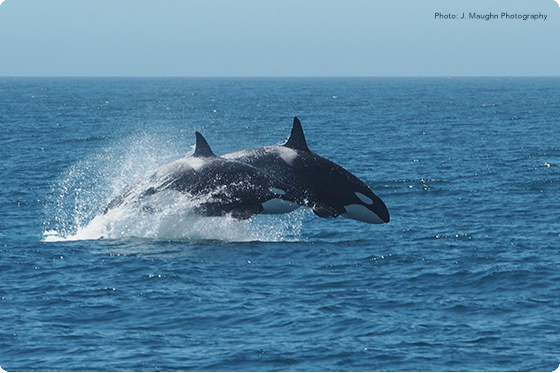
Last month, the National Marine Fisheries Service (NMFS) proposed a new rule to revise the critical habitat for the Southern Resident killer whale (Orcinus orca) in the Northeast Pacific Ocean. The proposed rule comes at a time when the species’ population size is at a historic low. In 1995, the highest census count for the species was 98. NMFS notes that in 2018 the Center for Whale Research counted just 75 whales remaining in the population. Since then, four of those whales died or were presumed dead, while two calves were born. Unfortunately, NMFS expects the population growth for the species to continue a downward trend over the next 50 years.
NMFS listed the Southern Resident killer whale as an endangered species in 2005. In order to further protect the species, the following year NMFS designated three areas in the inland waters of Washington State as critical habitat. In 2014, the Center for Biological Diversity (CBD) petitioned NMFS to revise this critical habitat designation to include areas of the West Coast of the United States that constitute essential foraging and wintering areas. NMFS went forward with the petition and presented a 90-day finding and a 12-month finding with steps to develop a proposed rule. In 2018, CBD filed an action to compel NMFS to issue the proposed rule. In April 2019, a federal district court approved a settlement agreement under which NMFS would issue a proposed rule by September 6, 2019.
In September 2019, NMFS released a proposed rule with six new coastal critical habitat designations for the Southern Resident killer whale along the West Coast. NMFS also identified three main threats to the Southern Resident killer whale: 1) scarcity of prey, specifically a decreased availability of the Chinook salmon which is dealing with its own population decline; 2) dependence on vocalization to navigate, communicate, and forage which requires open waterways free from acoustic obstruction to allow for movement within and between important habitat areas; and 3) serious potential health risks from persistent organic pollutants and exposure to petroleum hydrocarbons. The six new critical habitat designations along the coasts of Washington, Oregon, and Northern California aim to further protect the Southern Resident killer whale from these threats.
NMFS identified the specific areas eligible for critical habitat designation using a five-step process. The process included determining the geographical area occupied, identifying habitat features essential to conservation, delineating specific areas within the geographical area occupied where the features were found, determining whether any specific area may require special management, and determining whether any unoccupied areas were essential for conservation. Additionally, NMFS considered economic costs, impacts to national security, and the possible harm to Indian tribes that may potentially result from the critical habitat designation. After these considerations, NMFS proposed the exclusion of 9.7% of the potential coastal critical habitat because of overlap with a Department of Defense site.
The proposed rule is open for comments on the Federal Register website, and thus far, over 300 people have voiced their support and concerns. The comment period remains open until December 18, 2019. View the full text of the proposed rule here.












